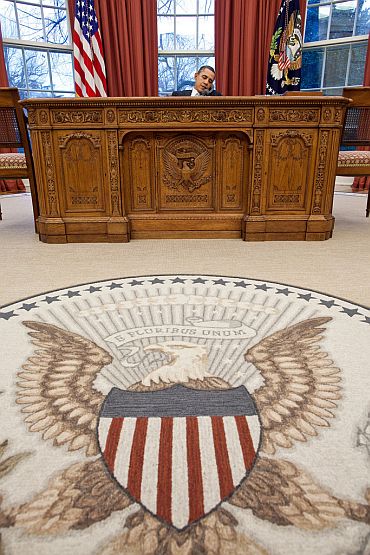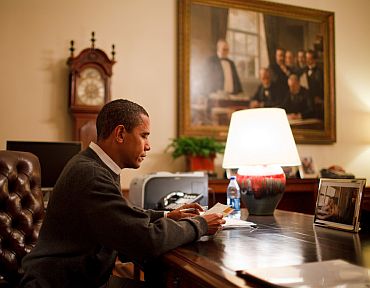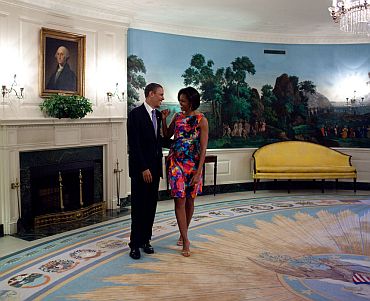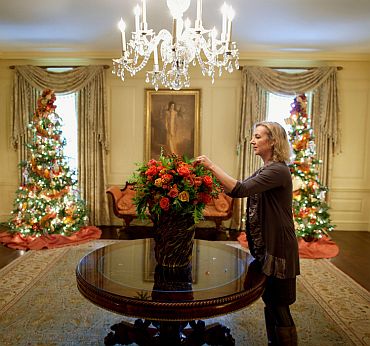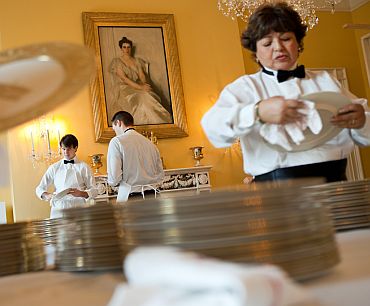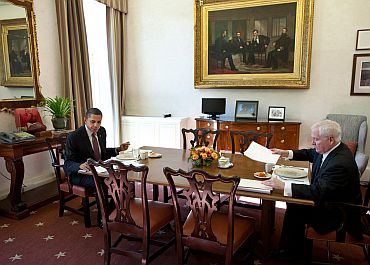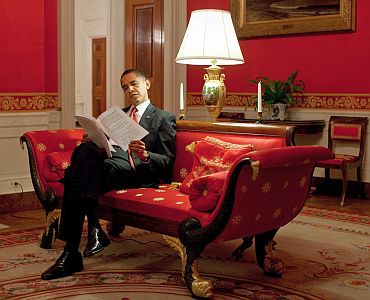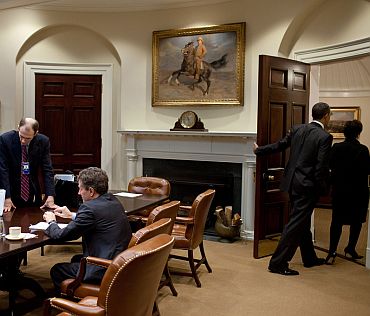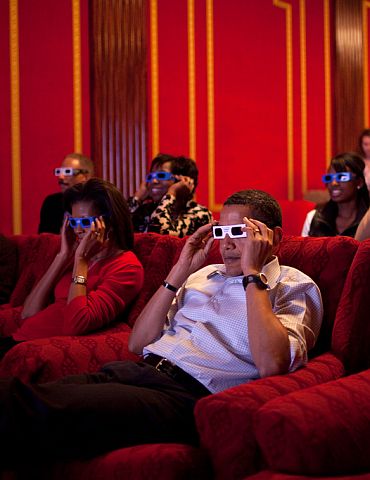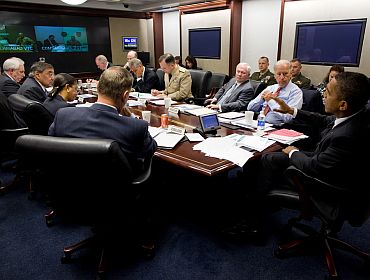 | « Back to article | Print this article |
Inside the fascinating White House
For two hundred years, the White House has stood as a symbol of the Presidency, the United States government, and the American people. Its history, and the history of the nation's capital, began when President George Washington signed an Act of Congress in December of 1790 declaring that the federal government would reside in a district "not exceeding ten miles square on the river Potomac."
Construction began when the first cornerstone was laid in October of 1792. Although President Washington oversaw the construction of the house, he never lived in it. It was not until 1800, when the White House was nearly completed, that its first residents, President John Adams and his wife, Abigail, moved in. Since that time, each President has made his own changes and additions.
There are 132 rooms, 35 bathrooms, and 6 levels in the White House. There are also 412 doors, 147 windows, 28 fireplaces, 8 staircases, and 3 elevators.
Rediff.com takes you on a trip inside the fascinating White House.
Click on NEXT to read further...
Inside the fascinating White House
The Oval Office
The Oval Office serves as the president's personal office and as a location for private meetings and conversations with aides and advisors.It's situated in the centre of the West Wing, connected to both the Cabinet Room and the Chief of Staff's office. It is frequently used to stage televised addresses and hold both private and public conversations with everyone from newly appointed members of congress to visiting heads of state.
Though perhaps the most iconic room in the White House, the Oval Office was not used as the President's personal office until after its renovations in 1902.
Though the room's eponymous shape is considered its most distinctive feature, the preference for oval rooms dates to the time of our first president, President George Washington -- other old rooms in the White House, such as the Blue Room, are also ovular
Inside the fascinating White House
Treaty Room
Originally part of the offices of the president on the White House's second floor, this room was used by several presidents as an audience or waiting room.
The venerable Treaty Table is the centerpiece of the room, brought back by Clinton designer Kaki Hockersmith. In addition to Theobald Chartran's depiction of the signing of the Spanish peace protocol, George PA Healy's The Peacemakers (1868), hangs in the room and depicts Abraham Lincoln conferring with his military advisers at the conclusion of the Civil War.
The great mirror over the mantel was one of two made for the Green Room in 1853. The mantel itself includes a plaque installed by Theodore Roosevelt, inscribed with the words, "This room was first used for meetings of the Cabinet during the administration of President Johnson. It continued to be so used until the year MCMII [1902]. Here the treaty of peace with Spain was signed."
Inside the fascinating White House
State Dining Room
The State Dining Room, which now seats as many as 140 guests, was originally much smaller and served at various times as a drawing room, office, and Cabinet room.
Not until the Andrew Jackson administration was it called the 'State Dining Room', although it had been used for formal dinners by previous presidents. The room is expanded from its original size and is now a little less than 49 feet by 36 feet.
When not set for a state dinner, the mahogany dining table, surrounded by Queen Anne-style chairs, displays part of Monroe's gilt service purchased from France in 1817.
The ornamental bronze-dore pieces are used today as table decorations. The plateau centerpiece, with seven mirrored sections, measures 14 feet 6 inches in length when fully extended. Standing bacchantes holding wreaths for tiny bowls or candles border the plateau.
Inside the fascinating White House
Diplomatic Reception Room
The Diplomatic Reception Room serves as an entrance to the White House from South Grounds for the family and for ambassadors arriving to present their credentials to the President. In the past, the area has had diverse uses: as a boiler and furnace room and as the site of President Franklin D Roosevelt's fireside chats.
Once a basement room used by servants for the polishing of silver, the room was taken over by a huge furnace in 1837. This was removed only in the 1902 renovation and the room converted to practical use. Today, it is about 36 1/2 feet by 29 feet.
The striking panoramic wallpaper in this room was installed by Jacqueline Kennedy in 1961. The paper is called 'Views of North America', and was first printed in 1834 by Jean Zuber et Cie in Rixheim, Alsace.
Starting to the left of the doorway from the Ground Floor Corridor are the Natural Bridge of Virginia, Niagara Falls, New York Bay, West Point, and Boston Harbour. Wooden blocks were used to print on panels composed of small sheets of paper.
Inside the fascinating White House
The Blue Room
The Blue Room is the centre of the State Floor of the White House. Over the years, the Blue Room's oval shape and breath-taking view of the South Lawn of the White House have captivated its visitors.
The Blue Room has been the customary place for presidents to formally receive guests.
Flowers are a traditional decorative feature of the room as is a distinctive marble-top table purchased by James Monroe in 1817.
In this room on June 2, 1886, President Grover Cleveland became the first and only president to be married in the White House. His bride, Frances Folsom, was not only 27 years his junior but also, at the age of 21, the youngest first lady in history.
Inside the fascinating White House
The Vermeil Room
The Vermeil Room, sometimes called the "Gold Room," was last refurbished in 1991; it serves as a display room and, for formal occasions, as a ladies sitting room.
The soft yellow of the paneled walls complements the collection of vermeil, or gold-plated silver, bequeathed to the White House in 1956 by Margaret Thompson Biddle.
This room is about 27 1/2 feet by 22 1/2 feet. The green silk draperies are of early 19th-century design. The carpet is a Turkish Hereke of about 1860, chosen for its pale green background and gold silk highlights.
In the centre of the room stands a circular mahogany table made in the Empire revival style later in the 19th century. Its tilt top is veneered in 12 wedge-shaped sections, each inlaid with a brass star. Hanging above it is a cut-glass chandelier with ten arms, which was made in England about 1785.
Inside the fascinating White House
Lower Press Office
The Lower Press Office is located behind a sliding door stage right of the famous podium.
Reporters, who may enter the area freely, first encounter a coat rack and a narrow wall covered in printouts of national front pages.
Two assistants, seated closely, sit to the right of the door, under a television.
With its cream-colored walls and hanging cabinets, the room resembles a cramped kitchen. The area is so small that one of the assistant press secretaries sits in another room called the Upper Press Office
Inside the fascinating White House
Old Family Dining Room
The first family often hosts small formal dinners in this room, a space about 28 feet by 25 feet. The first floor's smaller dining room was strictly for family meals, and was generally thought of as the "breakfast room" until 1961, when Jackie Kennedy created a dining room upstairs.
Some families chose not to use the Family Dining Room even before that. The Jackson clan ate on small tables in their rooms as if in a hotel, and the Eisenhowers dined on TV trays in the West Sitting Hall, simultaneously watching two "porthole" television sets.
The room often gets use as a staging area for state dinners and an "overflow" room for members of the president's staff who get bumped from the State Dining Room by last-minute guests
In the northeast corner is a door that is blocked by a cabinet. On the other side, the space formed the deep doorway (the wall is a brick wall more than 2 feet thick) provides a niche for an extra desk in the Ushers' Room.Inside the fascinating White House
Oval Office Private Dining Room
Just off the Oval Office, through a small corridor past the president's private study is the president's West Wing study and dining room, sometimes called the "Oval Office Dining Room" (some presidents use a smaller office next door as their private study).
In this room, the president may have casual meals alone or with staff and catch the news on television or discuss White House policy.
Because this room is usually furnished with a small television, it is often here that the president first sees news events being reported from around the world.
Inside the fascinating White House
The Red Room
The Red Room received its name in the 1840s from its vivid color scheme, made all the more striking by its small size. While many First Families have enjoyed the room, two first ladies in particular made special use of it:
Beginning in 1809, First Lady Dolley Madison held Wednesday Drawing Rooms that opened the doors for socialising between members of opposite political parties during a period of fierce partisan segregation. Her success as the Capital's hostess redefined the role of the First Lady and helped usher in pivotal discussions in the run-up to the War of 1812.
Very shortly after her husband's inauguration in 1933, First Lady Eleanor Roosevelt hosted the first of many press conferences for women reporters in the Red Room. Because women reporters were excluded from the president's press conferences, Mrs Roosevelt's press conferences erased a social barrier.
Inside the fascinating White House
Truman Balcony
In 1947, Harry Truman consulted with architects on the addition of a balcony off the Yellow Oval Room.
A committee was appointed, and a controversy erupted that spilled over into the newspapers and editorial cartoons. President Truman maintained that a balcony would help balance the south face of the White House by breaking up the long verticals of the columns, and provide shade for the first floor portico without the awnings commonly used at the time, which tended to become dirty.
Opponents argued that the tall columns were in keeping with the Federal style of architecture (and the Classical Greek style it was based on) and that adding a "porch" for the first family's leisure would ruin the look of the south side of the building. In the end, Truman prevailed and there was general agreement that the new balcony, finished in 1948, was an improvement in both form and function.
Inside the fascinating White House
The Green Room
The Green Room, located on the first floor of the White House, serves primarily as a state parlor and has long been a favorite of Presidents and their families due to its intimate scale and distinctive decor.
During his tenure in office, President John Quincy Adams named it the "Green Drawing Room," though the inspiration for the name may have come from President Jefferson's use of the space as a dining room, when he would cover the floor with a green-colored canvas for protection.
Among the most historically significant events in our nation's history occurred here -- the signing of our first declaration of war. President James Madison officially declared war on the British in 1812 in the Green Room. (Two years later, British forces would burn the Green Room -- and the rest of the White House -- to the ground.)
Decades later, President Abraham Lincoln held the funeral for his youngest son William Wallace here in February of 1862. First Lady Jacqueline Kennedy redecorated and refurbished the Green Room, along with many other notable rooms in the White House, in 1961.
Inside the fascinating White House
Roosevelt Room
The window-less Roosevelt Room occupies the original site of the president's office, built in 1902 during President Theodore Roosevelt's expansion of the White House.
Seven years later, when the West Wing was expanded and the Oval Office was built, the room became a part of two waiting rooms. When President Franklin D Roosevelt relocated the Oval Office from the center of the building to the southeast corner in 1934, this room received a skylight.
The second President Roosevelt called this room the Fish Room, since he used it to display an aquarium and his fishing mementos. President Kennedy continued the room's nautical theme by mounting a sailfish that he caught in Acapulco, Mexico.
President Richard Nixon named the room in 1969 to honor both Presidents Roosevelt for their expansions and improvements to the West Wing. Traditionally, the mantelpiece holds bronze busts of both presidents (as well as President Theodore Roosevelt's Nobel Peace Prize, the first awarded to an American) and their portraits hang on opposing walls. Today the room is used as a conference room and features a multimedia center for presentations.
Inside the fascinating White House
The Cabinet Room
The Cabinet Room opens directly into the Oval Office and overlooks the famed Rose Garden.
It serves as both a public and private space for presidents to communicate their priorities and receive advice and feedback from cabinet secretaries and advisors.
The centerpiece of the room is a large oval table, a gift from President Richard M. Nixon in 1970, surrounded by leather chairs.
Each chair is specifically assigned, with a small, engraved brass placard on the back indicating the position of the person meant to sit there.
The president is seated in the centre on the East side of the table.
Inside the fascinating White House
Family Theatre
The family theater was converted from a long cloakroom in 1942 when the current East Wing building was constructed. It overlooks the sculpture garden that Hillary Clinton established.
It has about 40 well-upholstered seats, set behind four big armchairs originally installed by Dwight Eisenhower. For many years, the decor was dominated by white curtains with a red floral design, but in 2004, it got a makeover in red.
The room is occasionally used to rehearse major speeches, like the State of the Union address each January, but much more often it is where the first family can indulge in one of the luxuries of the job -- a movie of their choice screened at any time of day and night for themselves and their guests, often sent direct from Hollywood before its release.
When the first East Wing was built in 1902, this part of the gallery was used as a cloakroom for the many coats and hats of guests visiting the mansion. Guests would proceed into the ground floor of the residence and assemble in what are today the Library (ladies' parlour) and Vermeil Room (gentlemen's parlour) before the event officially began.
Inside the fascinating White House
Situation Room
The Situation Room is a 5,000 square foot complex of rooms in the ground floor of the West Wing, some of which have windows looking out the west side of the building. It is sometimes called "the woodshed."
Contrary to popular belief, the White House Situation Room is not a bunker that is located deep underground.
In 2006, the Situation Room underwent a renovation to bring it up to date with new technology.
The main conference room now has six flat-screen televisions for secure video conferences, and the technology linking them to generals and prime ministers around the globe makes it less likely that the encrypted voices and images will go black (which happened regularly in connections to Baghdad).
Officials found the old room's wood-paneled walls too noisy, making it hard to hear for those listening in via video or telephone. The new room has less mahogany and more of what officials describe as "21st century whisper wall."
Not all presidents use the room in the same way. John Kennedy spent most of his time during the Cuban missile crisis in the Oval Office or the Cabinet Room and would go down to the Situation Room only to read the teletype.
Lyndon Johnson used the room so often during the Vietnam War that he left his Oval Office chair down there. Presidents Nixon and Ford almost never used the room. George HW Bush and Bill Clinton used it often. In most cases, a visit from the president is a formal undertaking. But George HW Bush would often call and ask if he could come in and say hello and see what was happening in the world.

